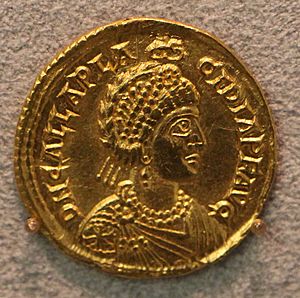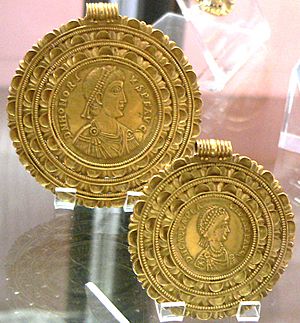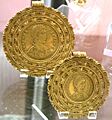Galla Placidia facts for kids
Quick facts for kids Galla Placidia |
|
|---|---|
| Augusta | |
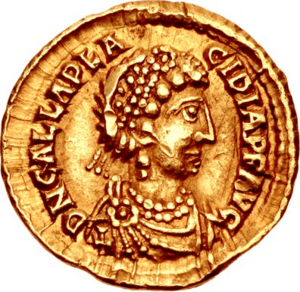
Tremissis of Galla Placidia
|
|
| Roman empress | |
| Tenure | 421 |
| Born | 388–89 or 392–93 |
| Died | 27 November 450 (aged 57–62) |
| Burial | Rome (she is not buried in the Mausoleum of Galla Placidia, Ravenna) |
| Spouse | Ataulf, King of the Visigoths Constantius III, Roman emperor |
| Issue |
|
| Dynasty | Theodosian |
| Father | Theodosius I |
| Mother | Galla |
| Religion | Nicene Christianity |
Galla Placidia (born around 388–393 AD, died 450 AD) was a powerful and important woman in the Roman Empire. She was the daughter of Theodosius I, a Roman emperor. Galla Placidia played a big role in Roman politics for most of her life.
She was a queen to Ataulf, the king of the Visigoths, from 414 to 415. She was also an empress to Constantius III in 421. Later, she became a regent for her young son, Valentinian III, helping him rule the Western Roman Empire until her death.
Contents
Who Was Galla Placidia?
Her Family and Early Years
Galla Placidia was the daughter of Emperor Theodosius I and his second wife, Galla. Her mother, Galla, was also from a royal family. Placidia was born either around 388-389 AD or 392-393 AD. Her mother died in 394 AD.
Placidia had two older half-brothers, Arcadius and Honorius, who also became emperors. As a child, she was given the special title of "nobilissima puella," meaning "most noble girl." This showed her high status.
Life with Stilicho's Family
Placidia spent many of her early years living with Stilicho and his wife, Serena. Stilicho was a very powerful general in the Western Roman Empire. He was in charge of both the cavalry (soldiers on horseback) and infantry (soldiers on foot).
Placidia was supposed to marry Stilicho's son, Eucherius. This marriage would have connected their families even more. However, in 408 AD, Stilicho was accused of plotting against the emperor and was executed. His son Eucherius was also killed.
Captured by the Visigoths
After Stilicho's death, many soldiers who were loyal to him joined Alaric I, the king of the Visigoths. Alaric led his army to Rome and put the city under siege from 408 to 410 AD. Placidia was in Rome during this time.
She was captured by Alaric before Rome fell. She then traveled with the Visigoths from Italy to Gaul (modern-day France). After Alaric died, his successor, Ataulf, became the new king.
Marriage to Ataulf
Ataulf wanted to make peace with the Roman Emperor Honorius, Placidia's half-brother. To strengthen this peace, Ataulf married Galla Placidia in Narbonne on January 1, 414 AD. Their wedding was a grand Roman celebration.
Placidia and Ataulf had a son named Theodosius, born in Barcelona. Sadly, their son died very young, which ended any chance of a new Roman-Visigothic royal family. In 415 AD, Ataulf was killed by one of his own men.
After Ataulf's death, Placidia was treated very badly by the new Visigothic king, Sigeric. She was forced to walk many miles with other captives. However, Sigeric was soon assassinated, and Wallia became the new king. Wallia made a peace treaty with the Romans and returned Placidia to her brother, Honorius.
Empress of the Western Roman Empire
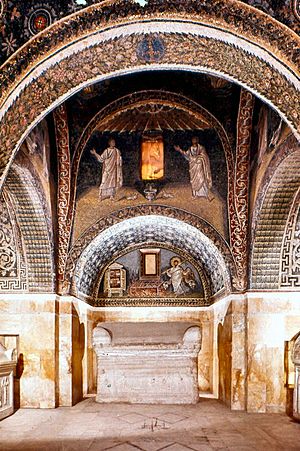
Marriage to Constantius III
On January 1, 417 AD, Placidia's brother Honorius forced her to marry Constantius III. Constantius was a powerful general who worked for Honorius.
Placidia and Constantius had two children: a daughter named Justa Grata Honoria (born around 417-418 AD) and a son named Valentinian III (born in 419 AD).
In 421 AD, Constantius was made co-emperor with Honorius, and Placidia was given the title of Augusta. This made her the only empress in the Western Roman Empire at that time. However, the Eastern Roman Emperor did not recognize their titles. Constantius died later that year.
Exile and Return to Power
After Constantius died, Placidia's relationship with her brother Honorius became difficult. She and her children were forced to leave Rome and go to Constantinople (the capital of the Eastern Roman Empire).
In 423 AD, Honorius died. Since he had no children, the throne of the Western Roman Empire was empty. A man named Joannes tried to become the new emperor. However, the Eastern Emperor, Theodosius II, decided that Placidia's son, Valentinian, should be the next emperor.
In 424 AD, Valentinian was given the title of Caesar, a step towards becoming emperor. Placidia and Valentinian traveled with the Eastern Roman army to Italy. They captured Ravenna, the capital of the Western Empire, and Joannes was defeated.
On October 23, 425 AD, Valentinian was officially declared the new Emperor of the Western Roman Empire. He was only six years old.
Regent for Valentinian III
Leading the Empire
Because Valentinian was so young, Galla Placidia became the regent. This meant she ruled the Western Roman Empire on his behalf. She was a very strong and influential leader.
One of her main challenges was dealing with powerful generals who wanted more control. Two important generals were Bonifacius and Flavius Aetius. Aetius was a skilled military leader who later became famous for fighting against Attila the Hun.
There was a conflict between Bonifacius and Aetius. Aetius tricked Placidia into thinking Bonifacius was disloyal. Bonifacius, believing Placidia was against him, made an alliance with the Vandals, a Germanic tribe. This led to the Vandals taking control of Roman Africa, a very important province.
When Placidia realized Aetius had tricked her, she tried to get Bonifacius to return. Bonifacius came back to Rome and fought a battle against Aetius. Bonifacius won the battle but was badly wounded and died a few days later.
Aetius's Influence
After Bonifacius's death, Aetius became the most powerful general in the Western Roman Empire. In 433 AD, Placidia recognized his power and gave him important titles, which put him in charge of the entire Western Roman army.
Placidia continued to be the regent until 437 AD, but Aetius had a lot of influence over decisions. She remained politically active until her death in 450 AD.
Later Life and Legacy
Galla Placidia was a very religious Christian. She helped build and restore many churches, including the Basilica of Saint Paul Outside the Walls in Rome and the Church of the Holy Sepulchre in Jerusalem. She also built the San Giovanni Evangelista, Ravenna church to thank God for saving her and her children during a storm at sea.
Her Mausoleum in Ravenna is a famous building and a UNESCO World Heritage Site. However, it was actually built as a chapel and was not her final resting place. She was buried in Rome.
In 450 AD, Placidia's daughter, Justa Grata Honoria, sent a letter and a ring to Attila the Hun, asking for his help to avoid an unwanted marriage. Attila interpreted this as a marriage proposal and demanded half of the Western Empire as a dowry. Placidia and Valentinian were very upset. Placidia convinced Valentinian not to kill Honoria.
Galla Placidia died in Rome in November 450 AD. She did not live to see Attila invade Italy, using Honoria's letter as his reason.
Images for kids
See also
 In Spanish: Gala Placidia para niños
In Spanish: Gala Placidia para niños


